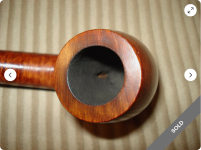@sablebrush52
Of course how you stated it would be more accurate, and I'm glad of your precision in place of my lack of it. Stating it to be the earliest documented is clearer. Regarding the COM stamp as shown in the catalog, I'm not clear about where you say it's stated in a single line. I think you're saying somewhere other than what is stamped on the photos of the pipes, and only one photo has the COM stamp visible at all, and that stamp is the two line version. Is that correct? Please accept my apologies if I've misunderstood something.
You're correct. The only LONDON over MADE appears on one photographed pipe.
On another page Comoy's displays a line up of their various brands of pipes:
Comoy's Comoy's H.C.
Yomoc Standard
PRIMA LONDON MADE LONDON MADE LONDON MADE LONDON MADE
LONDON MADE
Damn it, I had these nicely spaced with the name centered over the LONDON Made and this stupid software isn't retaining the spacing!
The top row are all the slanted cursive logo font with the swash "s" curving back under the name. The other rows are block. The H.C. is block in an oval frame. And all references to their LONDON MADE pipes are in capital letters. This slanted long swash logo was discontinued around 1921 - 22 if I remember correctly. I'd have to spend more time than I have currently to find that bit of documentation.
Catalogs are wonderful sources for information. For example, it was thought that Sasieni Town Names started around 1928. I found town names in Sasieni's 1924 catalog, published by their US distributor, Rapaport. I let Jon know and he did some further digging and found ads, beginning around November of 1923, featuring town names. We now know that Sasieni Town Names began in late 1923.
Ads are also a great source of information. Jon was able to use them to target the point at which Barling stopped stamping their stems with their REG'd number and replaced it with the BARLING
Design stem stamp as having occurred in March of 1951, when they announced the new stem stamp.
And if anyone tells you that they have a '40's Guinea Grain, they're mistaken. Barling didn't add that line until 1953 (or maybe it was 1952, my brain is getting fuzzy).
Accuracy matters. There's a listing in a 1917 catalog for a Barling Nibblick. So far, the few Barling Nibblicks that have shown up have been sandblasts. Does this mean that Barling invented the sandblast and Dunhill took credit for it, as some pipe nerds have stated? We don't know, because none have shown up from that period. The Nibblicks that I have are clearly late 1930's. We don't know for a fact that that 1917 Nibblick was a sandblast.








